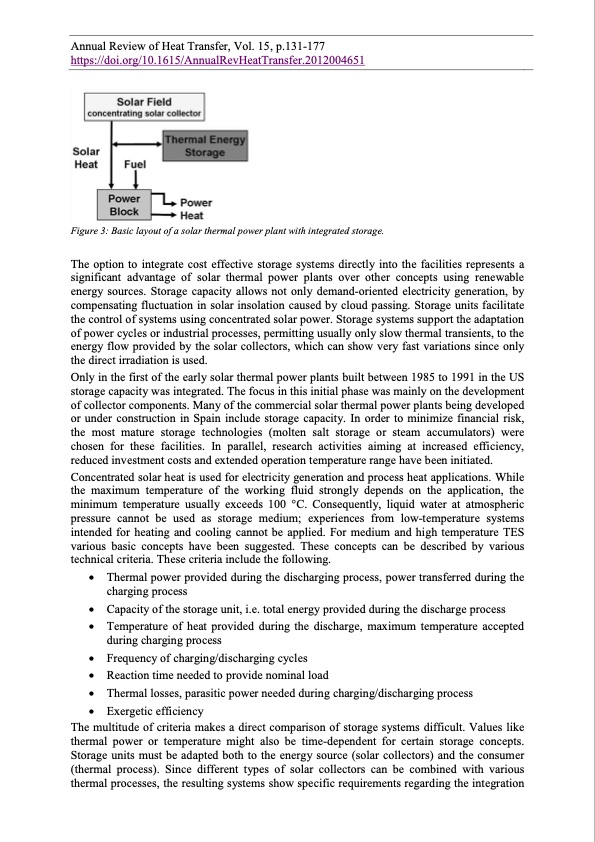
PDF Publication Title:
Text from PDF Page: 008
Annual Review of Heat Transfer, Vol. 15, p.131-177 https://doi.org/10.1615/AnnualRevHeatTransfer.2012004651 Figure 3: Basic layout of a solar thermal power plant with integrated storage. The option to integrate cost effective storage systems directly into the facilities represents a significant advantage of solar thermal power plants over other concepts using renewable energy sources. Storage capacity allows not only demand-oriented electricity generation, by compensating fluctuation in solar insolation caused by cloud passing. Storage units facilitate the control of systems using concentrated solar power. Storage systems support the adaptation of power cycles or industrial processes, permitting usually only slow thermal transients, to the energy flow provided by the solar collectors, which can show very fast variations since only the direct irradiation is used. Only in the first of the early solar thermal power plants built between 1985 to 1991 in the US storage capacity was integrated. The focus in this initial phase was mainly on the development of collector components. Many of the commercial solar thermal power plants being developed or under construction in Spain include storage capacity. In order to minimize financial risk, the most mature storage technologies (molten salt storage or steam accumulators) were chosen for these facilities. In parallel, research activities aiming at increased efficiency, reduced investment costs and extended operation temperature range have been initiated. Concentrated solar heat is used for electricity generation and process heat applications. While the maximum temperature of the working fluid strongly depends on the application, the minimum temperature usually exceeds 100 °C. Consequently, liquid water at atmospheric pressure cannot be used as storage medium; experiences from low-temperature systems intended for heating and cooling cannot be applied. For medium and high temperature TES various basic concepts have been suggested. These concepts can be described by various technical criteria. These criteria include the following. Thermal power provided during the discharging process, power transferred during the charging process Capacity of the storage unit, i.e. total energy provided during the discharge process Temperature of heat provided during the discharge, maximum temperature accepted during charging process Frequency of charging/discharging cycles Reaction time needed to provide nominal load Thermal losses, parasitic power needed during charging/discharging process Exergetic efficiency The multitude of criteria makes a direct comparison of storage systems difficult. Values like thermal power or temperature might also be time-dependent for certain storage concepts. Storage units must be adapted both to the energy source (solar collectors) and the consumer (thermal process). Since different types of solar collectors can be combined with various thermal processes, the resulting systems show specific requirements regarding the integrationPDF Image | Annual Review of Heat Transfer

PDF Search Title:
Annual Review of Heat TransferOriginal File Name Searched:
2012_Thermal_Energy_Storage_Materials_and_Systems.pdfDIY PDF Search: Google It | Yahoo | Bing
Turbine and System Plans CAD CAM: Special for this month, any plans are $10,000 for complete Cad/Cam blueprints. License is for one build. Try before you buy a production license. More Info
Waste Heat Power Technology: Organic Rankine Cycle uses waste heat to make electricity, shaft horsepower and cooling. More Info
All Turbine and System Products: Infinity Turbine ORD systems, turbine generator sets, build plans and more to use your waste heat from 30C to 100C. More Info
CO2 Phase Change Demonstrator: CO2 goes supercritical at 30 C. This is a experimental platform which you can use to demonstrate phase change with low heat. Includes integration area for small CO2 turbine, static generator, and more. This can also be used for a GTL Gas to Liquids experimental platform. More Info
Introducing the Infinity Turbine Products Infinity Turbine develops and builds systems for making power from waste heat. It also is working on innovative strategies for storing, making, and deploying energy. More Info
Need Strategy? Use our Consulting and analyst services Infinity Turbine LLC is pleased to announce its consulting and analyst services. We have worked in the renewable energy industry as a researcher, developing sales and markets, along with may inventions and innovations. More Info
Made in USA with Global Energy Millennial Web Engine These pages were made with the Global Energy Web PDF Engine using Filemaker (Claris) software.
Sand Battery Sand and Paraffin for TES Thermo Energy Storage More Info
| CONTACT TEL: 608-238-6001 Email: greg@infinityturbine.com | RSS | AMP |